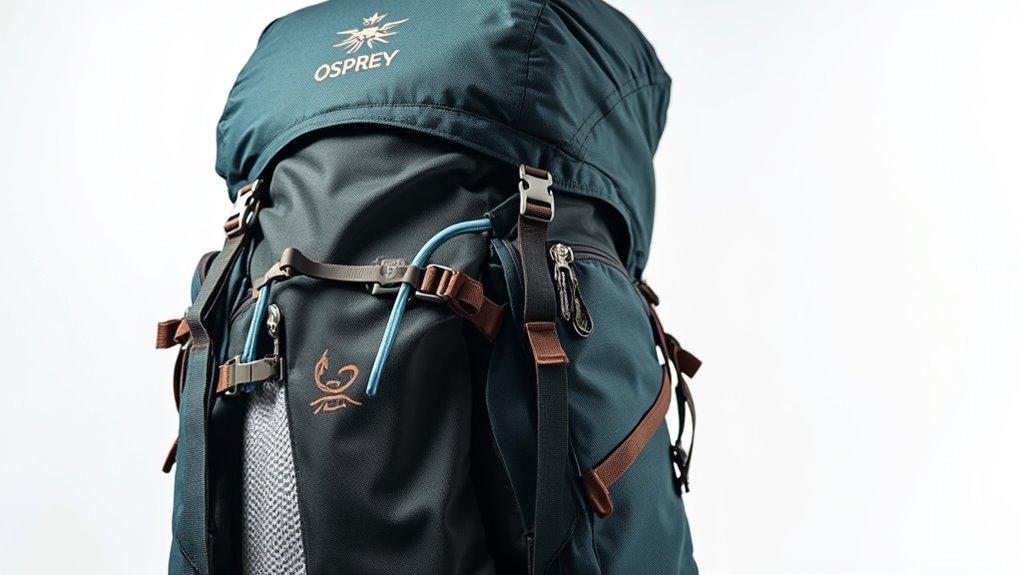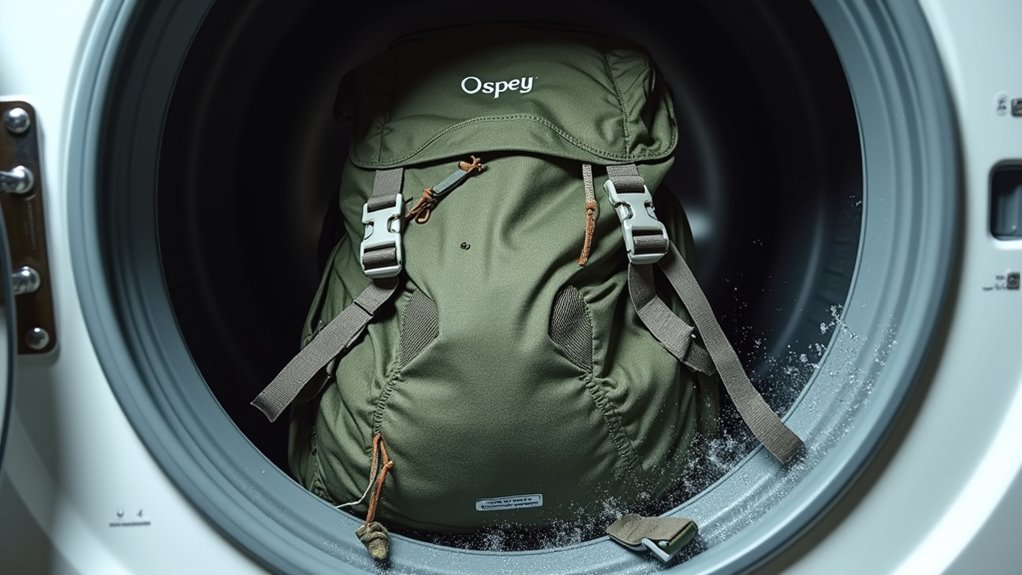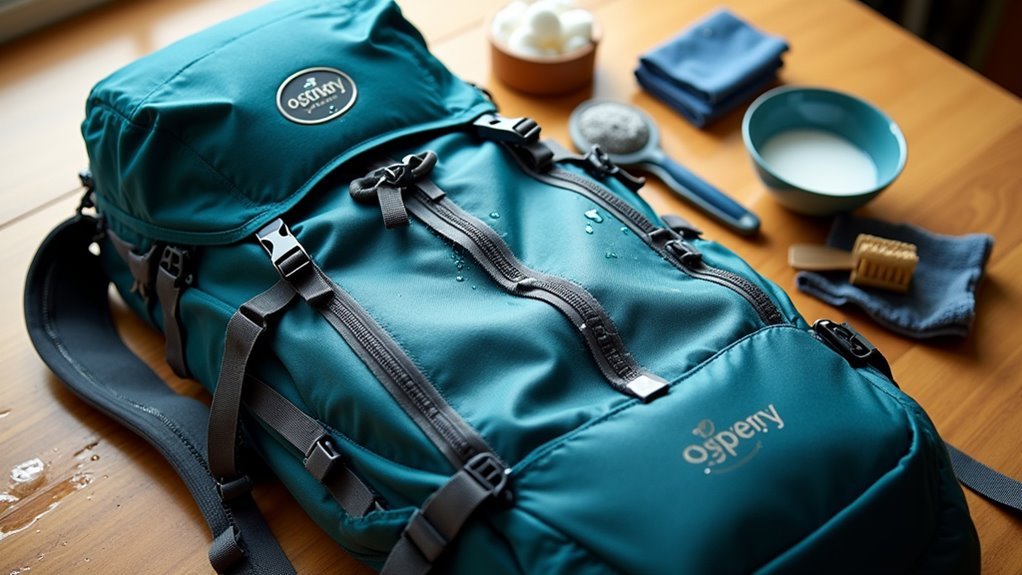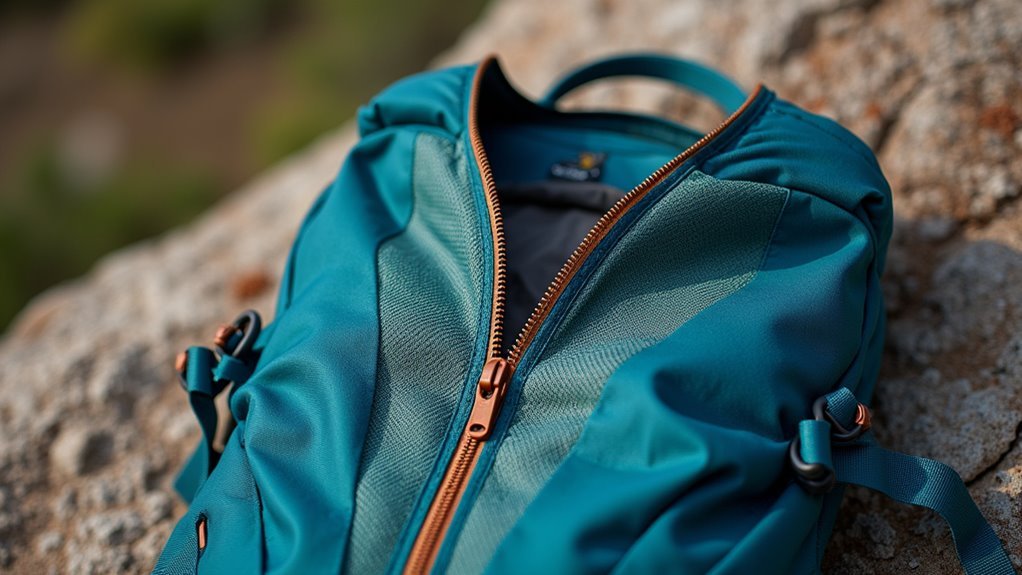I’ll be honest – caring for your Osprey backpack isn’t rocket science, but there’s definitely a right way to do it. I always hand wash mine with mild soap like Nikwax Tech Wash and a soft brush, because throwing it in the washing machine will void your warranty faster than you can say “adventure.” After each trip, I loosen all the straps to let the pack breathe and focus on cleaning those zippers and mesh panels where grime loves to hide. The key techniques I’ve learned will keep your gear performing like new for years.
Understanding Your Osprey Backpack’s Construction and Materials

Quality – that’s what sets Osprey backpacks apart from the crowd, and honestly, it’s something you’ll notice the moment you get your hands on one. I’ve found that understanding what goes into these packs really helps you appreciate why they’re built to last. Osprey engineers these backpacks specifically for adventurous souls who crave freedom – people like you who won’t settle for gear that holds them back. They use renewable, non-toxic, and recyclable materials, which is pretty impressive when you think about it. This construction isn’t just smart; it’s revolutionary for outdoor enthusiasts seeking reliable, sustainable gear. In fact, Osprey’s commitment to sustainable materials showcases their dedication to reducing environmental impact while ensuring top-notch performance.
Essential Cleaning Supplies and Recommended Products
Before you plunge into cleaning your Osprey backpack, you’ll want to gather the right supplies – and trust me, using the wrong products can actually damage that premium construction we just talked about.
I always start with mild soap. Regular dish soap works, but Nikwax Tech Wash is honestly worth the investment. You’ll also need a gentle brush – I use a soft-bristled toothbrush, though The Laundress Stain Brush works great too. Maybe grab the Hongjin Extra Soft Toothbrush if you’re ordering from Amazon anyway.
Regular maintenance, including hand washing your pack, protects its integrity while giving you the freedom to explore without worry.
What Never to Do: Washing Machine and Warranty Warnings

While it might seem convenient to toss your Osprey backpack in the washing machine – I mean, we throw everything else in there, right? – this is actually the fastest way to destroy your investment. The agitation damages the fabric and can wreck those carefully engineered seams. I’ve seen too many adventure-seekers learn this the hard way.
Here’s what’ll really sting: washing your pack improperly voids your warranty completely. You’re fundamentally throwing away Osprey’s legendary customer service and quality guarantee. Trust me, hand-washing isn’t just recommended – it’s your ticket to keeping that freedom-enabling gear functional for years. Additionally, always check the care label for specific cleaning instructions tailored to your backpack’s material.
Basic Maintenance Techniques for Regular Upkeep
Now that we’ve covered what not to do, let’s talk about the simple stuff you can do regularly to keep your pack in top shape. I think the key is staying ahead of problems before they actually become real issues.
Loosen all your straps after each adventure—it’s like letting your pack breathe. Grab a soft brush and mild soap mixture to scrub zippers, mesh panels, and webbing where dirt loves to hide. Well, these spots collect grime faster than you’d expect. I’m not entirely sure why, but regular brushing keeps everything moving smoothly and extends your pack’s life greatly. Additionally, applying protective sprays can help prevent stains and spills on fabric backpacks.
Step-by-Step Deep Cleaning Process

When your backpack needs more than surface cleaning, it’s time for the full treatment—think of it like giving your gear a spa day. I start by emptying everything and disconnecting removable parts. Then I turn it inside out—this actually gives you better access to trapped dirt. Fill your bathtub with warm water and mild soap; Nikwax Tech Wash works great. Submerge and scrub gently with a soft brush, paying extra attention to zippers and webbing. Rinse thoroughly until water runs clear. Don’t rush this step—leftover soap can damage the fabric over time.
Proper Drying Methods to Preserve Your Investment
How you dry your freshly cleaned backpack can make or break its lifespan—I’ve seen too many people ruin perfectly good gear by rushing this step.
Skip the dryer completely. Heat’ll shrink your pack faster than you can say “adventure ruined.” Direct sunlight’s equally brutal on the fabric.
Instead, find a shaded spot with good airflow. I hang mine upside down so water doesn’t pool in pockets. Turn it inside out first—well, maybe flip it back and forth halfway through drying. Remember, proper storage extends the lifespan of your backpack by protecting it from excessive heat and moisture.
Complete dryness is non-negotiable before storage. Trust me, mold isn’t the hiking companion you want.
Special Attention Areas: Zippers, Mesh, and Webbing

While your backpack air-dries, you’ve got the perfect opportunity to tackle the trouble spots that collect the most grime. These areas are like magnets for dirt and debris, so they need extra attention.
These grime-collecting trouble spots act like dirt magnets and demand your focused attention during the drying process.
- Zippers: Run your brush along the zipper tracks to remove sand and dirt buildup. I’ve found that clogged zippers can ruin a trip faster than anything else.
- Mesh pockets: Gently scrub the mesh fabric where sweat and trail dust love to hide. Don’t press too hard—you don’t want to tear the delicate material.
- Webbing straps: Focus on buckles and adjustment points where grime accumulates from constant handling during your adventures. Regular maintenance of zippers and hardware can help prevent unexpected failures and extend the life of your pack.
Storage Tips and Long-Term Care Strategies
Once your Osprey backpack is completely dry, proper storage becomes just as critical as the cleaning process itself. I think of storage like—well, it’s basically giving your pack a cozy home where it can rest between adventures. Proper storage is crucial to extending the lifespan of your backpack.
Store your backpack loosely packed in a cool, dry place. Don’t compress it for months; that’ll stress the materials. Actually, I always stuff mine with old clothes to help maintain its shape.
| Storage Do’s | Storage Don’ts |
|---|---|
| Loosely stuff with soft items | Compress tightly for months |
| Store in cool, dry areas | Leave in hot cars/garages |
| Keep zippers slightly open | Store completely sealed |
| Check periodically for issues | Forget about it entirely |
| Maintain shape naturally | Hang by single strap |
Frequently Asked Questions
How Often Should I Clean My Osprey Backpack During Heavy Use?
I’d clean your Osprey backpack after every 3-5 days of heavy use. Frequent adventures mean dirt, sweat, and grime build up quickly, so regular cleaning keeps your pack functioning efficiently and extends its lifespan for countless future expeditions.
Can I Use Fabric Softener When Cleaning My Osprey Backpack?
I’d skip fabric softener completely – it’ll coat your backpack’s technical fabrics and reduce their breathability and water resistance. Stick with mild soap only to keep your gear performing at its peak potential.
What Should I Do if My Backpack Gets Moldy or Mildewed?
If your backpack gets moldy or mildewed, I’d immediately clean it with mild soap and warm water using a soft brush. Focus on affected areas, rinse thoroughly, then hang it in a well-ventilated, shaded spot until completely dry.
How Do I Remove Stubborn Stains From My Osprey Backpack?
Like a warrior conquering dirt, I’ll tackle stubborn stains with mild soap and a gentle brush. I’ll scrub the affected area thoroughly, rinse completely, then air-dry in shade to keep my adventure companion pristine.
Is It Safe to Use Bleach on Light-Colored Osprey Backpacks?
I don’t recommend using bleach on your Osprey backpack, even light-colored ones. Bleach’s harsh chemicals can damage the renewable materials and void your warranty. I’d stick with mild soap solutions that’ll protect your pack’s integrity.